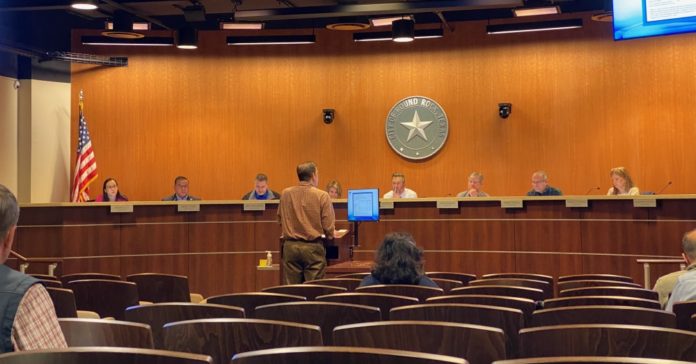Round Rock Utilities Director Michael Thane provided an update regarding the city’s increased inflow of wastewater during the City Council packet briefing March 8. (Brooke Sjoberg/Community Impact Newspaper)
The city announced on March 4 that its utilities department was investigating the possible source of excess inflow to its wastewater system, causing the Brushy Creek Regional Wastewater System Treatment Plant to emit more treated effluent into Brushy Creek than permitted to by the Texas Commission on Environmental Quality.
He said the city’s recent growth is not the cause of the increased inflow, as that can be accounted for based on the number of permits issued. Current inflow volume is exceeding a reasonable amount for issued permits, Thane said.
“There is a significant other problem that’s causing the increased inflow,” Thane said. “That’s what we’re trying to find right now.”
Thane said his department is working to find the source of the inflow, specifically looking at 17 segments of the city’s wastewater delivery system, so that it can be quickly repaired. Because the inflow must be coming from somewhere upstream due to its large volume, Thane said, they are inspecting the system’s larger wastewater interceptors most heavily.
Recent increases in intake have pushed the average over the past week to between 22 million-24 million gallons per day, or MGD, with peak flows between 32 MGD and 33 MGD. In May 2021, the approximate average was between 18 MGD and 19 MGD, the city said in the March 4 announcement.
Increased flow of water, according to the city, may be the result of ground and surface water inadvertently entering the wastewater system. City water operations noted these increases sporadically beginning in May 2021, a city report states. Organic solids, also referred to as “total suspended solids,” passed through the plant’s clarifiers to Brushy Creek during peak hours. The creek has since been inspected daily by city staff, and TCEQ officials have visited the plant on multiple occasions to confirm its compliance. The plant had been in compliance up until the last week, when intake levels dramatically increased.
The area is a popular fishing spot, and according to Patrick Ireland, the Texas Wildlife and Fisheries Inland Fisheries Division San Marcos and Austin District supervisor, one of only 10 strongholds of the state fish, the Guadalupe Bass. Ireland spoke during the public comment portion of the packet briefing, and he pointed out to the City Council that the increased effluent has consequences for wildlife.
“It’s a very valuable resource,” Ireland said. “It’s also a very diverse fish assemblage, which is not something you commonly see in many urban streams.”
Round Rock residents Martin Miller and Chris Johnson also expressed concerns that the standard thresholds of wastewater effluent composition for TSS, phosphates and other components were too high to begin with, even when they are in line with TCEQ regulation. Johnson owns Living Waters Fly Fishing, and he said the area is particularly popular with anglers due to the size of the Guadalupe Bass caught there.
Miller stated that even when the effluent is within TCEQ parameters, it has still left the creek “unusable” by residents for nine months out of the past year.
“It’s been just this side of an open sewer sometimes,” Miller said. “I sent a letter to each of you; I think it’s got pictures of the pile up of the solids at the low water crossing. It looked like a sewer last year.”
Round Rock Mayor Craig Morgan stated signs would be placed near the creek March 8 to warn residents of the water quality.
This is an ongoing story and will be updated as more information becomes available.
Credit: Source link





























